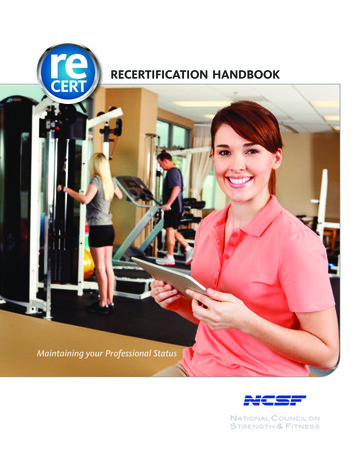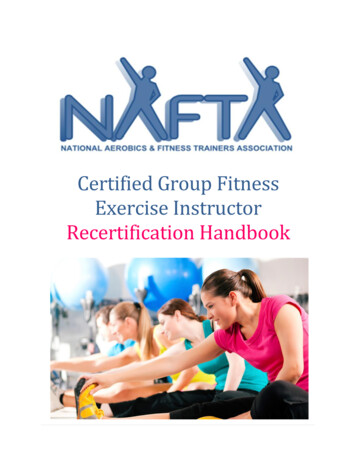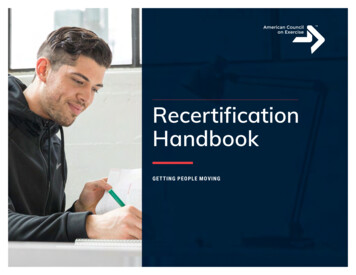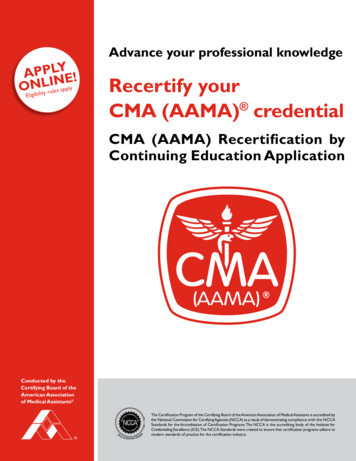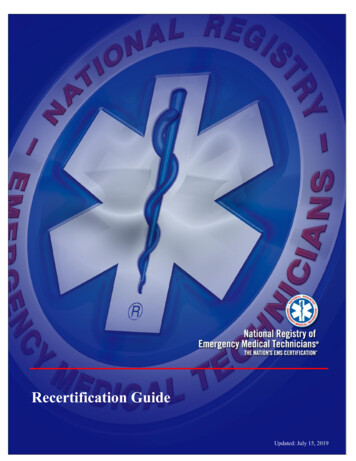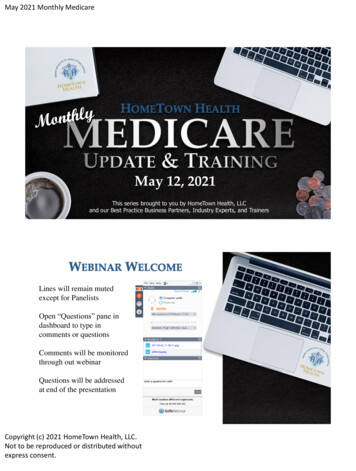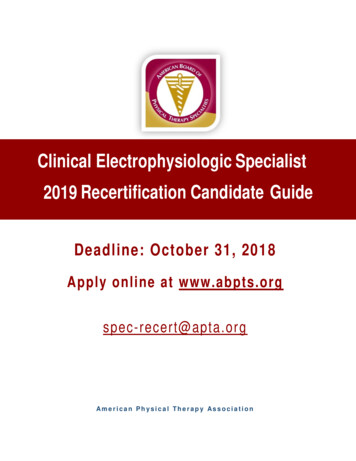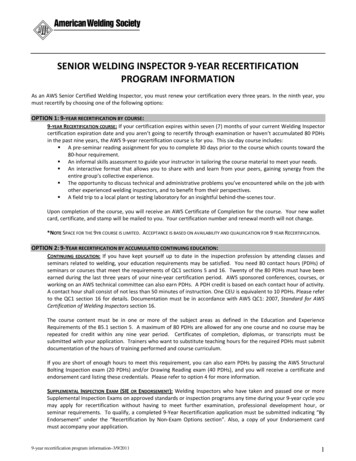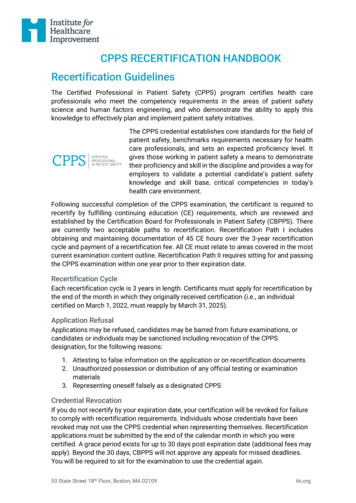
Transcription
CPPS RECERTIFICATION HANDBOOKRecertification GuidelinesThe Certified Professional in Patient Safety (CPPS) program certifies health careprofessionals who meet the competency requirements in the areas of patient safetyscience and human factors engineering, and who demonstrate the ability to apply thisknowledge to effectively plan and implement patient safety initiatives.The CPPS credential establishes core standards for the field ofpatient safety, benchmarks requirements necessary for healthcare professionals, and sets an expected proficiency level. Itgives those working in patient safety a means to demonstratetheir proficiency and skill in the discipline and provides a way foremployers to validate a potential candidate’s patient safetyknowledge and skill base, critical competencies in today’shealth care environment.Following successful completion of the CPPS examination, the certificant is required torecertify by fulfilling continuing education (CE) requirements, which are reviewed andestablished by the Certification Board for Professionals in Patient Safety (CBPPS). Thereare currently two acceptable paths to recertification. Recertification Path I includesobtaining and maintaining documentation of 45 CE hours over the 3-year recertificationcycle and payment of a recertification fee. All CE must relate to areas covered in the mostcurrent examination content outline. Recertification Path II requires sitting for and passingthe CPPS examination within one year prior to their expiration date.Recertification CycleEach recertification cycle is 3 years in length. Certificants must apply for recertification bythe end of the month in which they originally received certification (i.e., an individualcertified on March 1, 2022, must reapply by March 31, 2025).Application RefusalApplications may be refused, candidates may be barred from future examinations, orcandidates or individuals may be sanctioned including revocation of the CPPSdesignation, for the following reasons:1. Attesting to false information on the application or on recertification documents2. Unauthorized possession or distribution of any official testing or examinationmaterials3. Representing oneself falsely as a designated CPPSCredential RevocationIf you do not recertify by your expiration date, your certification will be revoked for failureto comply with recertification requirements. Individuals whose credentials have beenrevoked may not use the CPPS credential when representing themselves. Recertificationapplications must be submitted by the end of the calendar month in which you werecertified. A grace period exists for up to 30 days post expiration date (additional fees mayapply). Beyond the 30 days, CBPPS will not approve any appeals for missed deadlines.You will be required to sit for the examination to use the credential again.53 State Street 18th Floor, Boston, MA 02109ihi.org
Inactive Status PolicyBecause the field of patient safety is changing and evolving continually, the CPPS mustpursue ongoing education to stay current. For this reason, an inactive path or waiver ofthe CE requirement is not available.Retirement of the CPPS CredentialRetired status indicates that the CPPS credential may not be used in connection with anyjob-related activities as an employee or consultant. Retired CPPS do not receivecertification-related mailings. The credential may only be restored by passing theexamination.PATH I: CPPS Recertification by Continuing Education(CE) HoursTo be eligible for recertification by continuing professional education (CE hours), thecertificant must obtain and maintain documentation of 45 CE hours over the 3-yearrecertification period and pay the recertification fee. All CE must relate to areas covered inthe most current examination content outline.All continuing professional education that follows the CPPS Content Outline is accepted.It is not a requirement to have the hours approved as CPPS hours.Continuing professional education for CPPS recertification may include, but is not limitedto, such activities as:Educational ProgramsParticipation in lectures, workshops, education sessions or case presentations providedby a health care association or society, health care facility or provider of services to ahealth care facility, or an industry-recognized provider of education.Self-StudyExamples include: Audio conferences/webinars Online educational programs Writing questions for the CPPS Examination: 0.5 CEs are awarded for eachaccepted test item CPPS Self-Assessment Examination: completion of the Self-AssessmentExamination provided by PSIProfessional Speaking/TeachingExamples include presentations/abstracts made by you at a national, regional, state, orlocal professional association/society. Presentations given as part of your job or workresponsibilities are not accepted for recertification. Credit may be declared for twice thelength of the educational program or speech.Formal Publication of Articles or BooksAuthoring a chapter in a published book earns 10 CEs. Authoring at least two published inpeer-review journals or periodicals with documented circulation that exceeds 1,000readers earns 5 CEs.For more information, refer to the detailed table provided.53 State Street 18th Floor, Boston, MA 02109ihi.org
PATH II: CPPS Recertification by ExaminationTo be eligible for recertification by examination, the certificant must sit for and pass theCPPS examination within one year prior to their certification expiration date.Continuing Education (CE) TablesTypeEducation programTypeCodeAAnd/orSelf-study,including audioconference, oronline educationprogramAcademiccoursework (inperson or online)BProfessionalspeaking/teachingCAcademic coursedevelopmentDItem shingGDescriptionDocumentationParticipation in a lecture, workshop,education session or casepresentation provided by aprofessional healthcareassociation/society, healthcarefacility, or an industry-recognizedprovider of education. Multipleparticipations in the same course mayonly be counted once. The providermust award CEs or a similar measureof continuing educationFrom an accredited college oruniversity (1 semester credit 15 CEs;1 trimester credit 12.5 CEs; 1quarter credit 10 CEs).At an educational program or ameeting of a national, regional, state,or local professionalassociation/society. Credit may bedeclared for twice the length of theeducational program or speech.Multiple presentations of the samespeech/program may only be countedonce.Academic course developed andaccepted as part curriculum. Contentrelates to one of the exam domains.Credit may be declared for twice thelength of the academic course(double credit in Type B above)For the CPPS CertificationExamination, SAE, or Review Course.0.5 CEs are awarded for eachaccepted test item.Completion of the Self-AssessmentExamination provided by CBPPS earns2 CEs.Authoring a chapter in a publishedbook earns 10 CEs.Certificate ofattendance/certificate ofcompletion with CE hours earned.53 State Street 18th Floor, Boston, MA 02109Grade report or copy oftranscript.Letter from the organization towhich you spoke or copy ofconference book indicatingsession.Documentation from theacademic institution in which thecourse has been presented.Letter from CBPPS CredentialingCenter.Individual Mastery Report emailfrom PSI.Copy of the book chapter orarticle(s).ihi.org
Authoring an article published in peerreviewed journals or periodicals (asthe first, second, or senior author)earns 2.5 CEs.ResearchHPublications must:- Have been published oraccepted for publication withinthe 3-year certification cyclefor which continuingprofessional education isbeing sought;- Relate to a domain or taskincluded in the Exam ContentOutline;- Bear the author’s name, thepublication’s name, and thedate of publication; and- Have been published outsideof the certificant’s facility orplace of business(a) An institutional review board(IRB) research project relatedto one of the exam domains,completed during your 3-yearcertification period, for whichyou are clearly identified asone of the primaryresearchers, and research isnot a primary component ofyour employmentresponsibilities. Earns 15 CEs.(b) A completed dissertation,thesis, or graduate-levelscholarly project related to oneof the exam domains. Earns30 CEs.(c) Serve as a content reviewer onan IRB, dissertation thesis, orscholarly project that is not acomponent of youremployment duties. Earns 5CEs.(d) Serve on a grant oversightcommittee or technical expertpanel that is not a componentof your employment duties.Earns 5 CEs.53 State Street 18th Floor, Boston, MA 02109(a) Copy of IRB approvalletter or IRB letter ofexemption and a onepage abstract, no morethan 250 words,describing the researchstudy and findings andthe period when theresearch was conducted.(b) Dissertation, thesis, orscholarly project approvalletter and a one-pageabstract of no more than250 words that describesyour dissertation, thesis,or scholarly projectfindings and the timeperiod during which thedissertation, thesis, orscholarly project wasconducted.(c) Supportingdocumentation from theorganization describingthe work and the datesserved.(d) Supportingdocumentation from theorganization describingthe work and the datesserved.ihi.org
ProfessionalServiceIIHI Congress orForumJCPPS ReviewCourseKComplete 2 or more years of volunteerservice during your certification periodwith an international, national, state,or local healthcare-relatedorganization in which yourcertification specialty expertise isrequired. Accepted volunteer activitiesincluding serving on boards ofdirectors, committees, editorialboards, review boards, and taskforces. Earns 10 CEs.Attendance at annual IHI meetings.CE hours vary.Participation in a CPPS ReviewCourse. Live, webinar, or online. Earns6 CEs.Content CodeThe official description of yourvolunteer duties (e.g., copy of anofficial letter or other documentsfrom the organization attesting toyour service and dates ofservice).Certificate ofattendance/certificate ofcompletion with CE hours earned.Certificate of Participation.CPPS Content Outline Category123CultureLeadershipPatient Safety Risks & Solutions4Measuring & Improving Performance5Systems Thinking & Design / Human FactorsCPPS Content OutlineI.Culturea. Assessment of Patient Safety Culturei. Identify work settings with positive safety culture and those in needof improvementii. Target low-performing aspects of culture for improvementiii. Disseminate best practices from high-performing work settingsiv. Disseminate culture survey results within all levels of theorganizationv. Interpret culture survey resultsvi. Apply ongoing proxy measures of patient safety culture (e.g., nearmiss reporting, targeted surveys)vii. Administer validated surveys to assess culture of safetyb. Raising Awarenessi. Engage healthcare team in patient safety initiativesii. Provide learning opportunities for the healthcare team about:1. The value and process of reporting safety incidents.53 State Street 18th Floor, Boston, MA 02109ihi.org
II.2. The importance of timely disclosure to patients related toadverse events and unexpected outcomes.3. The importance of transparency and timely apology.iii. Address patient safety implications associated with operationalchanges (e.g., cost-reduction measures)iv. Include consideration of values, language, cultural background, andhealth literacy level in safety materials, treatment plans, etc.v. Provide formal and informal education to staff and leadership onapplying patient safety principlesc. Promoting a Culture of Safetyi. Advocate for the inclusion of the principles and science of patientsafety within initiativesii. Articulate principles of a fair and just cultureiii. Disseminate information about patient safety activities on a regularbasisiv. Ensure the involvement of patients and caregivers in the patients’healthcare decisionsv. Promote the involvement of patients and caregivers in the patientsafety teamvi. Promote a collaborative work environment that includes all whosupport patient carevii. Facilitate a systems approach to address disruptive workplacebehaviorsviii. Foster organizational support for healthcare team membersinvolved in adverse eventsix. Develop reporting feedback loops for informing individuals andgroups about unsafe conditions, near misses, and incidentsLeadershipa. Align patient safety strategy with organizational mission, vision, values,and goalsb. Advocate for patient safety as a top priorityc. Identify key stakeholders for distinct patient safety initiativesd. Develop operational plan to improve patient safetye. Advocate for resources required to support the operational safety planf. Foster transparent communication:i. Throughout the organization.ii. With patients and their caregivers.g. Create opportunities for interdisciplinary patient safety conversations andproblem solvingh. Integrate patient safety responsibilities into job descriptions,competencies, and performance evaluation toolsi. Embed accountability into investigations and system improvementj. Promote the application of principles of high reliability at all levels of theorganizationk. Demonstrate the ability to influence decision makers and direct careproviders to participate in patient safety initiativesl. Use storytelling as a mechanism to engage stakeholders and drive changem. Work within the organization to accomplish process improvement,effectively engage leaders, and influence stakeholders and direct careproviders53 State Street 18th Floor, Boston, MA 02109ihi.org
III.n. Provide patient safety content expertise for continuous regulatoryreadinesso. Promote compliance with requirements related to reporting seriousoccurrences and reportable events to appropriate organizationsp. Develop approaches that address the different priorities and perspectivesof diverse stakeholdersq. Collaborate with key stakeholders to prioritize patient safety efforts,including:i. Executivesii. Managersiii. Cliniciansiv. Direct care providersv. Governing bodyvi. Patients and their caregiversvii. Accrediting agenciesviii. Regulatory agenciesPatient Safety Risks & Solutionsa. Risk Identification & Analysisi. Implement a systematic approach to respond to data sources (e.g.,safety alerts, product recalls, industry alerts)ii. Develop a mechanism to report identified hazardsiii. Perform activities to identify gaps and risks (e.g., failure modes andeffects analysis (FMEA), walk-arounds)iv. Review reports of unsafe conditions, near-misses, and incidentsv. Ensure support is provided for staff affected by safety-relatedadverse eventsvi. Identify vulnerable populations with a high likelihood of patientsafety events (e.g., diabetes, extremes of age, potential foraddiction)vii. Perform Root Cause Analysis (RCA)viii. Share findings and action items from safety investigations withdirect care providers and other departmentsix. Recognize the risks of workplace physical and psychologicalviolence involving:1. Patients2. Staff/care providers3. Familiesb. Patient Safety Solutionsi. Perform critical evaluation of evidence for applicability to aprogram or initiativeii. Evaluate evidence-based best practices for organizationalimplementation of:1. Bundled care processes2. Simulation3. Clinical decision tools (e.g., checklists, algorithms, carepathways)4. Team training5. Communication techniques (e.g., to transfer patient care,escalate concerns)iii. Evaluate technology solutions to promote patient safety:53 State Street 18th Floor, Boston, MA 02109ihi.org
IV.V.1. Information technology (e.g., EMR, CPOE, decision support,apps, augmented / artificial intelligence, monitoringtechnology)2. Medication safety-related technology (e.g., barcoding,pharmacy robots, technology-informed infusion devices)iv. Monitor patient safety outcomes following the implementation ofnew or modified technologyv. Investigate how the interface between technology systems maycontribute to patient safety eventsvi. Investigate how the interface between technology and users maycontribute to patient safety eventsvii. Identify and disseminate local safety innovations throughout theorganizationviii. Evaluate risks associated with existing, modified, or newtechnology systemsMeasuring & Improving Performancea. Measurementi. Identify quantitative patient safety data sources for internal andexternal reportingii. Identify qualitative patient safety data sources (e.g., walk-arounds,event reporting, patient feedback, patient and family advisorycouncil)iii. Collect patient safety dataiv. Manage patient safety datav. Analyze patient safety data using statistical techniques (e.g.,statistical process control)vi. Interpret patient safety datavii. Develop credible and understandable reportsviii. Present results of data analyses to stakeholdersix. Evaluate feedback from standards organizations (e.g., forregulators, accreditation, and ratings, etc.)b. Improvementi. Select an improvement methodology that is relevant to an initiativeor projectii. Apply improvement methodologies to promote measurablyimproved processesiii. Use process, outcome, and balancing measures to evaluate systemperformanceiv. Employ project management skills to manage the work ofimprovementv. Employ facilitation skills to promote teamworkSystems Thinking & Design / Human Factorsa. Systems Thinkingi. Systemically identify, define, and address patient safety issuesii. Identify normalized deviance (e.g., drift) in processes or systemsiii. Recognize rule violations as an indicator of potential system designor performance flawsiv. Differentiate among human error, behavioral choices, and systemfailuresv. Apply systems theory53 State Street 18th Floor, Boston, MA 02109ihi.org
1. Identify relevant systems elements (people,tools/technology, tasks, environment, organizations andtheir interaction)2. Plan for unintended consequences of changevi. Apply systems thinking to improve processes1. Identify workflows2. Understand workflows3. Collaborate with direct care providers and managementleaders to identify problems with processes4. Identify barriers to improving processes5. Use a ranking system to prioritize patient safety concerns6. Use a ranking system to prioritize sustainable solutions7. Evaluate the degree to which proposed solutions match rootcauses8. Evaluate the strength of interventions, such as training,forcing functions, policy9. Design/redesign solutions with the help of stakeholders(e.g., patients, direct care providers, management)10. Consider potential unintended consequences whenstandardizing processes11. Implement sustainable solutions12. Evaluate sustainable solutionsb. Design / Human Factorsi. Recognize how key components of systems interact to determinesafety:1. People (e.g., health literacy, cultural competency, physicaland cognitive abilities)2. Tools, technology, and techniques3. Tasks (clinical and nonclinical)4. Environment5. Organization (including culture, financial decisions, rules,staffing, etc.)ii. Apply principles of high reliability and resilience to system designiii. Incorporate regulatory/accreditation requirements in designingprocess improvement initiativesiv. Identify and address factors that negatively impact humanperformance (e.g., limitations of memory, time constraints, multitasking, interruptions, stress, fatigue and lack of sleep, thedetrimental effect of shift work, ergonomics)v. Identify and enhance factors that support human performance(e.g., pattern identification, anticipation of outcomes, criticalthinking, teamwork)100 TOTAL ITEMSApproximately 17% of the items will require recall on the part of the candidate, 53%will require application of knowledge, and 30% will require analysis. All examinationforms will include 10 unscored pretest items.53 State Street 18th Floor, Boston, MA 02109ihi.org
Applying for CPPS RecertificationTo apply for recertification:-Complete the applicationPathy I only: Attach copies of the required documentation, with documentsmarked to correspond with the list of Continuing Education typesPath I only: Enclose the recertification fee or make payment online, ifapplicable (make checks payable to CBPPS)Scan and submit via email (cpps@ihi.org) **preferred method**Or mail to:Institute for Healthcare ImprovementATTN: CPPS Recertification53 State Street, 18th FloorBoston, MA 02109Only completed applications will be processed. A completed application must bereceived by the end of the month in which you were originally certified to ensurecontinued certified status. Applications received up to 30 days past the expirationdate will be subject to a late fee. After the 30-day grace period, successful retest isrequired for recertification.Please allow 6-8 weeks for processing of your recertification application.Questions? Contact us at cpps@ihi.org or 617.391.9927.53 State Street 18th Floor, Boston, MA 02109ihi.org
CPPS RECERTIFICATION APPLICATIONDate Certified (MM/DD/YYYY): / /Name:FirstMiddle InitialLastOrganization:Job Title:Mailing Address:Contact Phone: ( )Email:PATH I: Recertification by Continuing Education (CE) HoursRequirements:Certificant information‘Continuing Education Documentation’ worksheetHardcopy documentation for hours claimedRecertification feePATH II: Recertification by ExaminationCertificant informationPSI passing score reportI hereby verify that the information contained in this recertification application is true andaccurate.Signature/ /Date53 State Street 18th Floor, Boston, MA 02109ihi.org
PAYMENT (PATH 1: Continuing Education only)Please visit https://my.ihi.org/cppsrecertification to pay online.Amount*:Non-members: 175 USIHI Premium Members: 158 USIHI Premium Members: 140 US*International mailing addresses: please add 50 US processing fee.Receipts available upon request.53 State Street 18th Floor, Boston, MA 02109ihi.org
CONTINUING EDUCATION DOCUMENTATIONTitle and Description of ActivityProvider orSponsoringOrganization53 State Street 18th Floor, Boston, MA 02109Date mentationAttached?ihi.org
Title and Description of ActivityProvider orSponsoringOrganization53 State Street 18th Floor, Boston, MA 02109Date mentationAttached?ihi.org
B From an accredited college or university (1 semester credit 15 CEs; 1 trimester credit 12.5 CEs; 1 quarter credit 10 CEs). Grade report or copy of transcript. Professional speaking/teaching C At an educational program or a meeting of a national, regional, state, or local professional association/society. Credit may be
